On this page:
What are pedestrian priority streets?
Pedestrian priority streets give high priority to walking and cycling, while allowing low-speed motor vehicle traffic (under 40km per hour). These streets are usually found in areas of intense and diverse activity such as activity centres, education facilities and public transport interchanges.
They accommodate diverse travel modes as well as provide a public space function. Bicycle lanes may either be provided as a separate lane, or a shared path with other modes. Streets may also restrict vehicle types or access at times.
Why is it important?
Pedestrian priority streets perform many functions. They are comfortable and safe for all pedestrians, including those with a disability, and provide a safe environment for low-speed cycling. They can also be the setting for informal activity such as performers and vendors.
Well-designed pedestrian priority streets encourage walking and cycling. Higher pedestrian numbers support the viability of nearby businesses, and allow uses such as cafes and restaurants to 'spill out' on to the street.
2.2.1: ensure pedestrian priority streets maximise the convenience and safety of walking and cycling modes
- Co-locate the pedestrian, bicycle and vehicle paths.
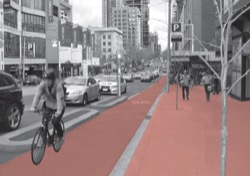
Tip: locating mode paths side by side increases the likelihood of informal surveillance, as there are more people on the street, more of the time. When pedestrian-only malls and separated pedestrian paths have low levels of activity they can feel unsafe. - Allocate a greater portion of street space to pedestrians and cyclists.
Tip: pedestrian priority streets work best with high levels of pedestrian traffic and of activity within adjacent buildings.
- Where there are high numbers of pedestrians and low numbers of vehicle movements, create a ‘shared zone’.
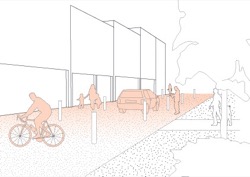
Tip: if an existing street or lane is too narrow to provide a footpath that complies with Disability Discrimination Act requirements there may be no option but to treat the street as a ‘Shared Zone’. - Keep the kerb radius at intersections to a minimum to encourage vehicle traffic to slow down when turning left into side streets.
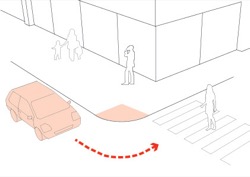
Tip: the kerb radius should be kept to a minimum compatible with street cleaning, bus movements and road safety requirements. See Guideline sources and references.
2.2.2: ensure the interface between the pedestrian priority street and buildings supports pedestrian amenity and safety.
- Place doors and windows of buildings to overlook the street.
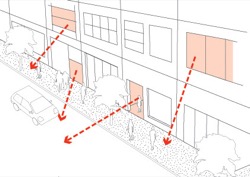
Tip: refer to 5. Buildings. - Include splays to driveway exits from laneways, buildings and car parking facilities to maintain sightlines from vehicles.
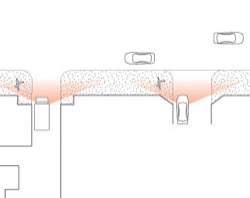
Tip: refer to VicRoads Supplement to the Austroads Guides to Road Design. - Provide space within the street for activities that support adjacent uses.
Tip: to attract pedestrians, streets need to provide a high level of interest for users. Street spaces can accommodate outdoor dining, vendors, public art, performance and recreation.
- Where possible integrate shelters and awnings onto the building facade on pedestrian priority streets.
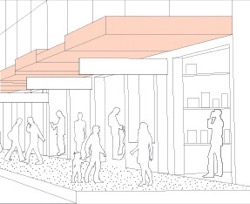
Tip: integrating shelters, by attaching them onto the building wall, allows the street spaces to remain uncluttered. Building Code of Australia sets out design standards for building projections beyond the street alignment. Refer to 5.1 Buildings in activitt centres and 6. Objects in the public realm.
2.2.3: relate the scale of surrounding buildings to the pedestrian priority street
- Use street width, building height and landscape design to create a sense of enclosure for street users.
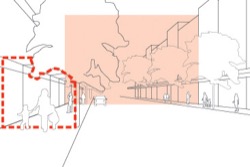
Tip: the ratio of building height to street width can affect pedestrian activity. Narrow streets can encourage pedestrian activity. Refer to 5. Buildings. - Arrange the street furniture and finishes to emphasise the pedestrian space.
Tip: emphasising pedestrian spaces, for example by using entry markers and changed paving, sends a message to all street users that pedestrians are the priority.
2.2.4: manage the use of the pedestrian priority street as an active public space
- Implement programs to facilitate and manage activities in the street space.
Tip: refer to 3.2 Street spaces and plazas.
- Enable adjacent businesses to use the street space for café furniture and to display merchandise.
Tip: kerbside dining brings activity into the street. Increase the street space available for social activities as demand increases.
- Implement programs to enliven blank building walls.
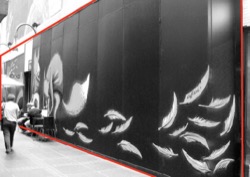
Tip: architectural detail, wall art, lighting and advertising can transform windowless walls into attractive facades.
2.2.5: maintain clean, attractive and serviceable pedestrian priority streets
- Design streets to facilitate efficient maintenance.
Tip: poorly maintained streets are known to influence perception of safety.
- Promptly remove graffiti and replace damaged furniture.
Tip: damaged public furniture should be quickly removed and replaced to reinforce care and the perception of a safe environment. See Element 6 Objects in the public realm.
Page last updated: 28/10/25